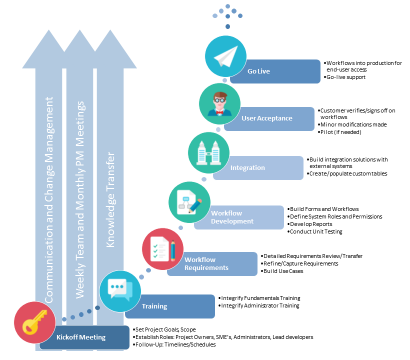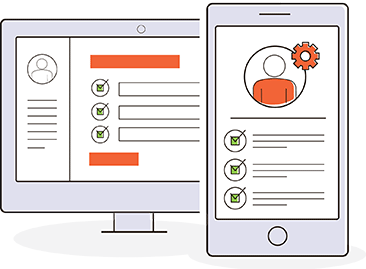Process Implementation
Transform how your organization implements new processes for greater efficiency

Process Implementation
Are your business procedures and processes slowing you down? Do you need to overhaul the way work is done within your organization? Process implementation is a strategic approach to changing how businesses approach, plan, develop and launch new working modes.
Rethinking how you implement new processes can transform an organization's operations at all levels. From streamlining tasks to driving efficiency, implementation requires a bold approach to rethinking how businesses operate day-to-day. It's a powerful way to transform how work gets done, drive growth and improve profitability.
How is it Used?
Implementing new processes intelligently means rethinking business operations at a fundamental level. It uses a reproducible implementation framework that can be used to address multiple challenges in the way a business runs.
Over time, processes can evolve and adapt to new conditions, personnel, and needs. Often, these changes are good and effective. Occasionally, however, the changes incorporate ways of doing work that are not as efficient or productive in the long run and at an enterprise level.
Success will mean considering new strategies, priorities, clients, markets, or growth goals. Intelligent implementation empowers leaders to think about achieving those important business considerations at a systemic level.
Process implementation can be used for various types of business needs, including:
- Maximizing the impact of existing workflows
- Developing new workflows
- Addressing operational problems
- Expanding operations to scale up
- Fostering business growth or expansion to new markets, products, or services
- Creating better outcomes
What are the Benefits?
Whether replacing ineffective processes or developing new ones, thoughtful implementation is critical to improving how a business runs. Among the core benefits are:
- Improved Outcomes. The primary benefit is to improve multiple operational aspects of the company. A thoughtful implementation approach allows an organization to develop a continuous development, evaluation, and improvement mindset.
- Streamlined Workflows. Rethink the way workflows operate. With automation, these workflows can save considerable time, labor, and money by eliminating the manual completion of recurring tasks.
- Better Outputs. When you reimagine processes, you will create better products and services. Looks at the inputs of your processes and the outputs, significantly shaped by the articulated desired outcomes.
- Scalability. Often, processes and procedures work for startup businesses but fail to scale. When growth opportunities emerge, it’s essential to have tools that allow for better operations. New processes can systematize work to scale up as the business expands.
- Efficiency. Processes require rigor and repeatability. Ensure that everything runs efficiently, reducing wasted time and labor. Efficient processes will automate the most mundane tasks and focus employees on more complex, critical areas.
- Compliance. Compliance is an increasingly outsized requirement for businesses of all types. Regulators expect processes that provide security of data and users while ensuring consumers have access to and control of data. Ensure that all activity complies with multiple regulations affecting business operations. Improving processes ensures that organizations are not susceptible to costly penalties due to non-compliance.
Steps for Effective Process Implementation
Organizations should use a well-defined and articulated series of steps to maximize the implementation work to lead teams to successful outcomes. The primary steps are:
- Define Priorities. Before a project begins, leadership must determine what it is trying to achieve. Determining which processes or procedures need to be improved and in which order are key planning elements.
- Select the Team. The implementation team will include those with the right experience, skills, and knowledge of the examined processes. Often, these teams span multiple departments, job titles, and roles.
- Seek Feedback. Proper implementation relies on knowing what is working and what needs to be improved. Feedback from employees, especially those who use the process, is essential.
- Set Objectives and Goals. Before the team begins its work, it should clearly understand the desired outcomes.
- Communicate the Process. Be sure that users and others who need to know to understand what is being evaluated and why.
- Determine Best Practices. In each phase, you’ll want to determine how to change best and automate the process using best practices from the industry and users.
- Design and Implement. Using powerful tools like those from Integrify, the team can develop and test new processes before launching.
- Activate and Assess. Once you’ve launched the new process improvements, you’ll want a period where users can evaluate and assess what’s working and make adjustments as necessary.
How Can Integrify Help Implement New or Better Processes?
Our implementation team can help your organization plan a thorough implementation plan for your processes using our process automation platform.
Our goal for every implementation of Integrify is to set you up for complete and total success. That means giving you skilled project managers, developers, and support resources (fortunately, we have many). While the overall structure of the Integrify implementation process is relatively predictable, we recognize that your organization is unique and will use Integrify in ways that best suit your business processes.
That's why Integrify was built to be highly configurable and why we've invested in building a fantastic implementation team to help with your automation and process improvement projects.
The Integrify process automation platform enables teams to work collaboratively to improve business operations. It has three core components:
A typical Integrify implementation will look like this (click for larger):
Design
The design component uses low-code drag-and-drop features to build better workflows. The tool allows for task assignments, approvals, and test runs of the new processes for quality control.
Implementation team members can collaborate on the design, share notes and add comments. Additional tools check for task dependencies. Once complete, the process design can be copied and exported.
Workflow
The workflow component lets teams create business rules that help manage exceptions, approvals (single, group, or multi-tiered), and routing. Users can create parallel or sequential workflows, child processes, reminders, notifications, and pauses.
Integration
The integration component connects new processes with other enterprise systems using an open, REST-based API or AWS Lambda technology.
Interested in Process Implementation?
We have a library of resources to help you on your journey to a more efficient workplace.


